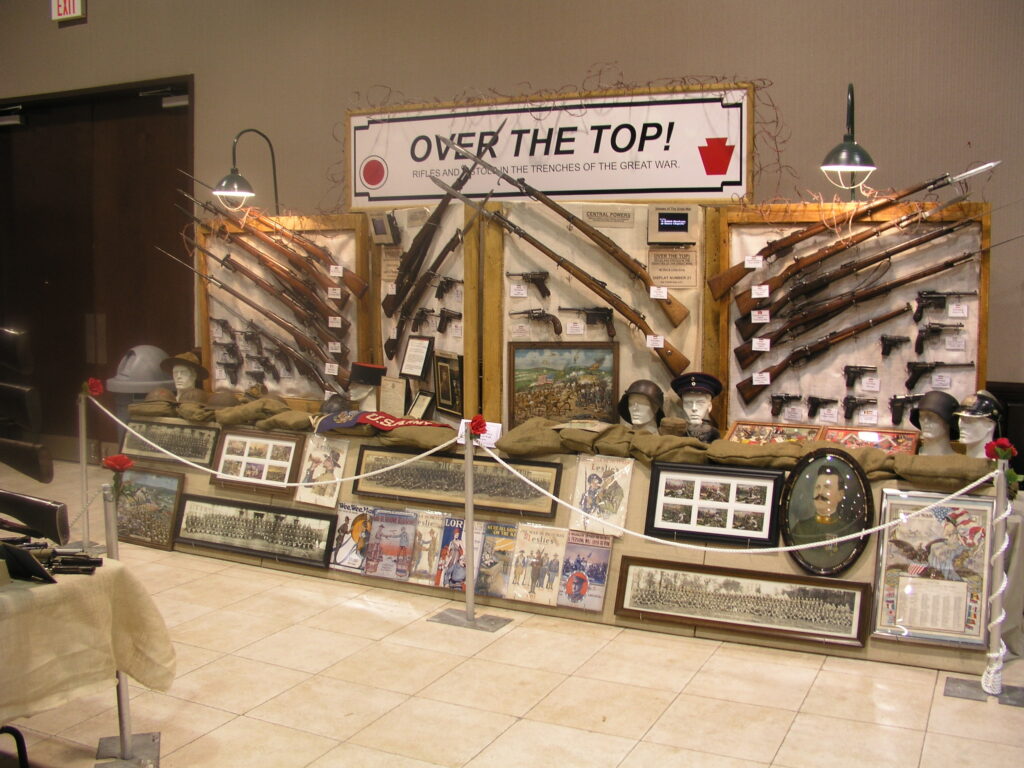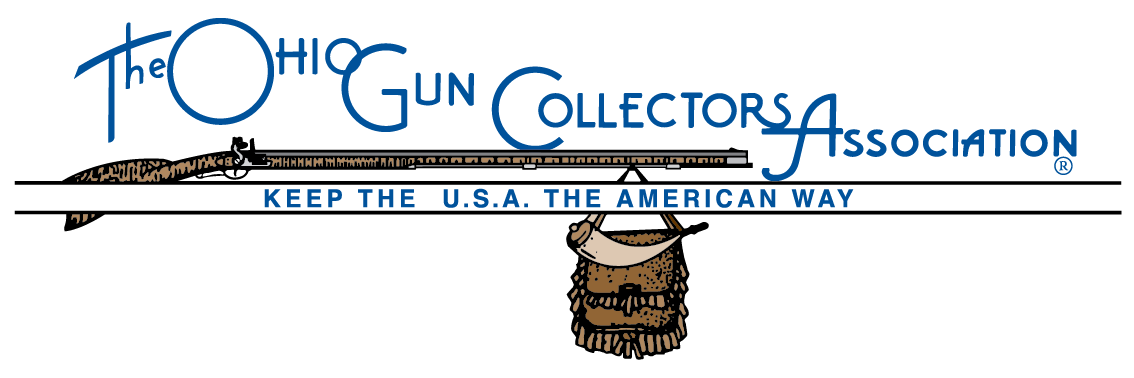WWII Firearms Addiction
I find myself looking at my collection with a feeling of great concern and thinking “Somebody should have told me.” I was warned of the ‘habit forming’ properties of alcohol and drugs, but nobody even hinted that I could fall victim to a World War II Firearms addiction. A smile takes over my face as I conclude, “I sure am glad nobody warned me!!!”
In truth the condition has progressed beyond a simple addiction to firearms collecting. It started with an urge to make a connection with these artifacts of history. Then the disease rapidly spread into an insatiable quest for knowledge (with the requisite library of books from the likes of Canfield, Cate, Kuleck, and Duff). Then without warning the disorder became about something entirely different… …people, fellow collectors, friends.

How it began…where did they come from…
A certain predisposition for this condition may be hereditary. In my case it was passed from my father in the form of a beautiful ac44 Walther P.38 with matching magazines and holster. He had acquired it when I was a boy along with a collection of coins and a couple of other firearms. When I had reached an appropriate age, I opened a birthday gift from my father to find this long-coveted treasure was mine.
The gestation period of the addiction from this first exposure was several years. When I completed college, I began to think of other interesting firearms my father had owned when I was younger. I quickly concluded that I must have an M1 Carbine. It was the gun of WWII movie heroes, army surplus bargains, and stories my father told of tracers inadvertently advertising his target practice one evening.
I headed off to several local gun shows, often taking my father with me. We were surprised to find a number of my father’s friends that we hadn’t seen in 10 or more years were at the shows. On one of their tables I found the prize I had been seeking. It was an Inland M1 Carbine in Excellent condition except for the aftermarket stock, which brought it down into my price range and was easily replaced with a GI stock. Before long, my father was hooked again and together were regularly going to shows.
Diagnoses: Addicted to collecting WWII Firearms
A certain predisposition for this condition may be hereditary. In my case it was passed from my father in the form of a beautiful ac44 Walther P.38 with matching magazines and holster. He had acquired it when I was a boy along with a collection of coins and a couple of other firearms. When I had reached an appropriate age, I opened a birthday gift from my father to find this long-coveted treasure was mine.
The gestation period of the addiction from this first exposure was several years. When I completed college, I began to think of other interesting firearms my father had owned when I was younger. I quickly concluded that I must have an M1 Carbine. It was the gun of WWII movie heroes, army surplus bargains, and stories my father told of tracers inadvertently advertising his target practice one evening.
I headed off to several local gun shows, often taking my father with me. We were surprised to find a number of my father’s friends that we hadn’t seen in 10 or more years were at the shows. On one of their tables I found the prize I had been seeking. It was an Inland M1 Carbine in Excellent condition except for the aftermarket stock, which brought it down into my price range and was easily replaced with a GI stock. Before long, my father was hooked again and together were regularly going to shows.
If you buy a gun……buy a book.
By the time I had acquired examples of most of the well-known arms of WWII, my addiction had started to move into the quest for knowledge stage. I had purchased books to learn more about the values and variations of the firearms I owned (or wanted), searched the internet, and interrogated dealers and collectors for bits of information. At first the knowledge was just a means to continue my mission. I “needed” to know what type of rifle Poland used,
did France use 35A & 35S pistols in WWII, and did Luxemburg even have any arms of their own (still looking into this one)? That was when I realized how much information there was on some topics, and how little there was on others.
With the objective clearly established I needed a seemingly simple set of information, a list of WWII combatant nations and the arms they used. To my surprise this was not readily available. Even most lists of WWII combatant nations had obvious omissions. Books on military arms tended to be either too broad, listing arms from various periods, or too narrow, covering only certain types or nations. This is not to say the books weren’t valuable. Editions like Military Small Arms of the 20th Century, Cartridges of the World, The Blue Book of Gun Values, Standard Catalog of Firearms, and dozens of others were indispensable in my research. Ultimately, I would have to build my own list. Even after several years I am still occasionally finding arms, and even nations to add to my list.
Display Shows
Over time I was becoming pretty satisfied with my collection and found I spent more time reading and talking about WWII firearms then I did buying or trading them. I created a web site, www.wwiifirearms.com, to share pictures and information on the topic, and I was starting to think more about the OGCA display shows. My wife and I set-up at our first OGCA Display Show in 2001. We didn’t have anything that would be called “rare” and most of our 40 or so guns were of only average condition. Our display was homemade by a guy that never took shop class (me), and it showed. Even so it was a great experience.
For two days straight members and guests came by in a steady stream. Many had similar interests and would stay to talk or ask questions. Young kids, veterans, and avid collectors alike were kind in complementing the display and thanking us for bringing it out. Even with a display that didn’t compete in quality with many others at the show the people made me proud of our display. They appreciated that not everyone is interested in only the exotic and unfired guns. Some people connected with these relatively inexpensive, well used, artifacts of history as types of guns they owned and enjoyed. My appreciation for my collection was being validated by those who visited, and it felt great. Without my knowing my addiction was becoming about the people.
OGCA 2003
The next OGCA display show was in 2003, this time I knew I wanted to do something for the people that were coming to see the display. We arranged the display tables so people could step out of the aisle and spend time looking at the guns up close, and we set-up computer terminals where visitors could look-up information about the guns from the web site. Again, the world class exhibits of OGCA Display Show would offer plenty of options for people to spend time looking at some fantastic firearms. Still, many of them decided to spend few extra minutes looking at our wall of relatively common firearms, and I loved it. I talked to people who told me things about guns in my collection I would have never known. People came back to report that they had seen something I was missing for sale in the show. Others went home and came back with guns they thought I might be interested in. We had a great time, and filled a few holes in the collection.
Guns of National Matches, making great friends
You meet so many great people while participating in OGCA Display Shows it is hard to know what opportunities will come about. In 2003 I was contacted by a fellow Display Show participant, Jim O’Neil, about a unique opportunity. The National Matches were about to celebrate 100 years of marksmanship competition, and they were interested in putting together a display of National Match firearms.
Jim had long been involved in competitive shooting, and I was just starting to get into the sport. Before I knew it a team of OGCA members, shooters, and Civilian Marksmanship Program (CMP) employees was being assembled to put together a display. We had so much fun we did it twice, once for the National Matches and again for the NRA National Convention (and OGCA meeting). The display has been discussed in earlier newsletter articles. It was great and even earned awards at the 2004 NRA convention, but for me the real treasure was the people I met in the process.
I learned a ton from the display team members and from all the OGCA members and directors that got involved. They knew how to put something for everyone in a display. They knew how to make a display look good for casual observer, informative for serious enthusiast, and even appealing to display show judges. I was trying my best to apply
what I was learning to my own display for the 2004 OGCA Display Show. One thing I learned is that it is a lot more fun when you aren’t in it alone.
Our 2004 OGCA Display
This was a real family affair. My wife and my mother were my chief designers and consultants, my father headed up research and procurement, and my two-year-old son and I handled building display components out in the barn each night. We came up with bigger display signs, WWII style barracks lights, Eisenhower D-Day letter handouts, and over 200 sandbags just to give it the right look. Assembly at the display hall took almost nine hours, but we were having a good time (except maybe mom who got stuck filling sandbags with newspaper for hours).
The OGCA Display show offered some unique experiences. Once again I had the most fun interacting with all the members and visitors. I am not sure what got more comments our collection of WWII firearms or all those sandbags mom filled with newspaper. We had the opportunity to meet and talk to General Tibbets, pilot of the Enola Gay during the first atomic bomb raid on Japan. General Tibbets is one of the most interesting people you will ever meet, and he delivered a great talk at the annual OGCA banquet. It was very flattering to win Member’s Choice and Best Educational awards, but I’d do it even if they didn’t have awards.
Our 2005 OGCA Display
As you might have guessed I’ll be back for the 2005 Display Show. This time it will be something different, simpler, and more about people. Whether you’re in the early stages of a .22 target rifle addiction, or fully involved in European sporting arms dependency problem, I hope you’ll consider setting up a display at these years show. You will have the opportunity to meet other collectors, educate others about the arms that interest you, likely learn a thing or two, and maybe even take home some awards and cash prizes.


